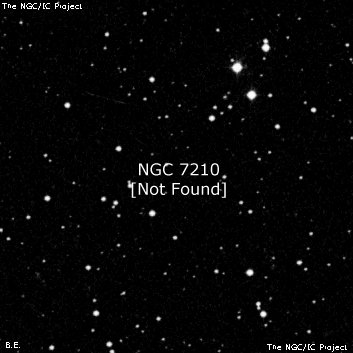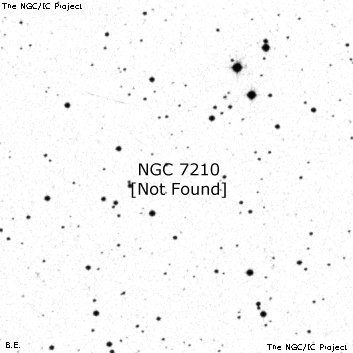NGC/IC Project Restoration Effort
(This is a very very beta version)
NGC7210


Basic Information
Location and Magnitude
Right Ascension: 22:6:22.0
Declination: +27:6:36
Constellation: PEG
Visual Magnitude:
Historic Information
Discoverer: Herschel J.
Year of discovery: 1827
Discovery aperture: 18.3
Observational
Summary description: eF, R, bM, vF D * np
Sub-type: NF
Corwin's Notes
=====
NGC 7210 = NGC 7487. JH's RA is one hour too small, and the GC and NGC NPD is
one degree too large. Earlier, I had written this:
NGC 7210 is lost. There are notes about it in GC and NGC. Dreyer has a
note in LdR's 1880 monograph that the object is the only nebula found by JH
in Sweep 103 (I scanned JH's 1833 list between 14 hours and 8 hours, and
found no others). In addition, JH marked both RA and Dec with double
colons; he apparently had reason to doubt the position. Finally, his north
polar distance is one degree less in the 1833 list than it is in GC (Dreyer
adopts the GC position for NGC) -- this was apparently not noticed by anyone
who tried to find N7210. Unfortunately, there is nothing matching JH's
description at either position.
For the record, that description reads, "eF, R, bM, ill-defined; a vF double
star 45[deg] np 4' dist points just to it." I scanned the POSS1 prints for
several degrees around JH's nominal position, but found no galaxy in the
area with a faint double where JH placed it.
So, even with two positions and a striking description, the object remains
at large.
Checking in the Herschel Archives in April 2016, I've found that Sweep 103 is
a most unusual one: it has only three objects in it, two double stars and
this one nebula. There are no "standard" stars with known positions. Here is
the left page of the sweep in full:
103 h m s
1 22 41 20 -14 2 Q = 25 7 30 D [diagram] 60 np or sf 4" 10=10m
neat[?]
Swept below Sweep by [illegible]
2 { 51 55 -17 1} Q = 24 15 30 D [diagram] 80 nf 10" 8&10m or 8.9&10
{ 52 30 -17 2} [illegible]
3 23 0 20 -16 2 Q = 23 50 40 N Extremely F. R. bM. ill def
a very faint d star 40[deg] np dist 4' +- points just
to it.
Index = 0. 12 25} Q = 18[deg] 7' 10"
0. 12 35} Mean i = 0 12 30
Sweep 103. Sat Nov 17 With the Quadrant, the PD pieces[?] being in
use for the sweep to follow.
And the right page
103 Sw 103
Red in RA to 1828
1 D 21 39 29.7 64 0 20 __
1st w -0 1 7.9 2 D 50 38.6 63 8 20 __
2nd w -0 1 43.8 3 N 58 28.7 62 43 30 21 58 35.5 62 43 0:: R
Red in PD
PD = Q^t + 38[deg] 52' 50"
Red of 2nd wire
Finally, there is a line at the beginning of the next sweep (104) on the same
night:
0 23 1 +- -------- 0 12 30 Q^t ------- Q^t = 18.7.10 To connect
this with Sweep 103
Working through this, we see the usual object number within the sweep, its
clock reading and chronometer beat, the wire number, and -- in place of the
usual NPD index -- a quadrant reading. This is followed by the object type
(D = double star, N = nebula), then the description. Following that are two
index readings, their mean, and the "Q = 18 7 10" from Sweep 104.
On the right page is the reduction to 1828 for each object. Note that the
hour here is shown as "21", not "22" as we might expect from the clock
readings. The nebula has been further reduced to 1830 with a colon added to
the NPD and an "R" following to indicate that the object has been entered in
the "Register", the master list of nebulae ordered by RA. Next is the
equation to reduce the PD, and last, a note to indicate that the reduction was
referred to the second wire.
At the beginning of Sweep 104, the mean NPD index is repeated, along with the
Q^t needed for Sweep 103.
All this, plus the different NPDs, led me for a while to believe that the main
error must be in one of the NPDs. This is the only case I've seen in JH's
sweeps where the NPDs are determined in such a roundabout way. However,
accepting JH's equation for the "Red[uction] in PD" leads to the same NPDs
that he shows on the right page. So, the incorrect NPD appearing in the GC
and NGC must be a transcription error.
Next, Working through the clock readings, beats, and wire corrections shows
that the RAs were reduced consistently, though I do not yet know how JH zeroed
them. The only problem is that the reduced positions on the right-hand page
all begin, as I noted above, with "21" hours.
Where did that "21" come from? The recorded hours are either "22" for the
doubles, or "23" for the nebula, so the "21" -- like the incorrect degrees of
NPD -- must be a transcription error.
Adopting the corrected numbers for the RA hours and the NPD degrees leads us
to NGC 7487 for the nebula. The description fits, including the "vF double
star 45[deg] np 4' dist points just to it."
Similarly, the two double stars are found close to the corrected positions.
For the record, JH's positions are 22 47 42, +26 53.3 for h 943; and 22 58 55,
+27 46.2 (both J2000.0) for h 950. With these positions, it's clear that JH
found a double previously credited to Hough from 1883 -- it is "Ho 297" =
WDS 22479+2652; and independently discovered a double found by Struve,
[Sigma] 2967 = WDS J22590+2745. My thanks to Brian Skiff and Yann Pothier for
the updated information on these two doubles.
In any event, simple transcription errors of 1 hour in RA and 1 degree in NPD
are the culprits for NGC 7210's erroneous position.
Steve's Notes
=====
NGC 7210
See observing notes for NGC 7487.



